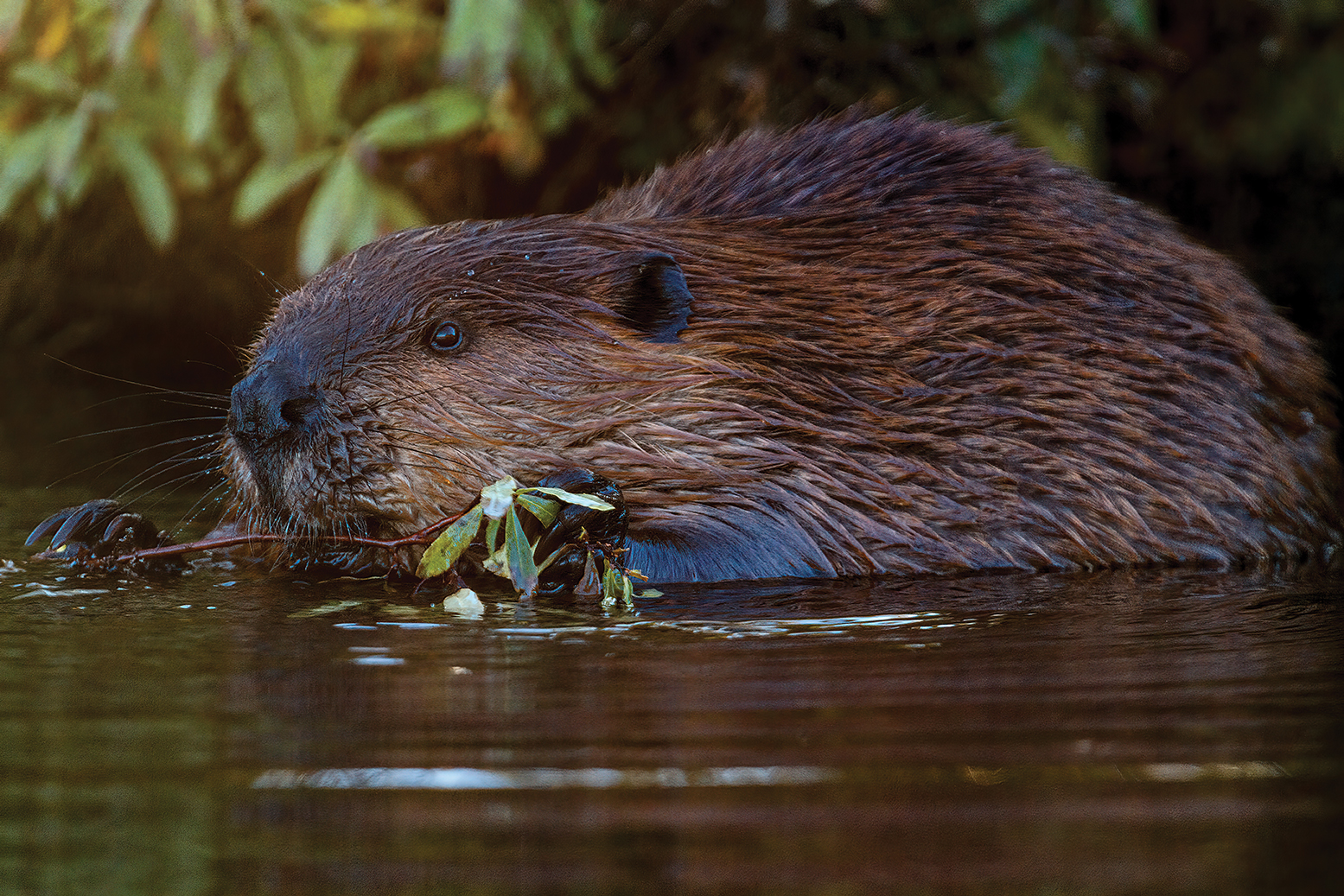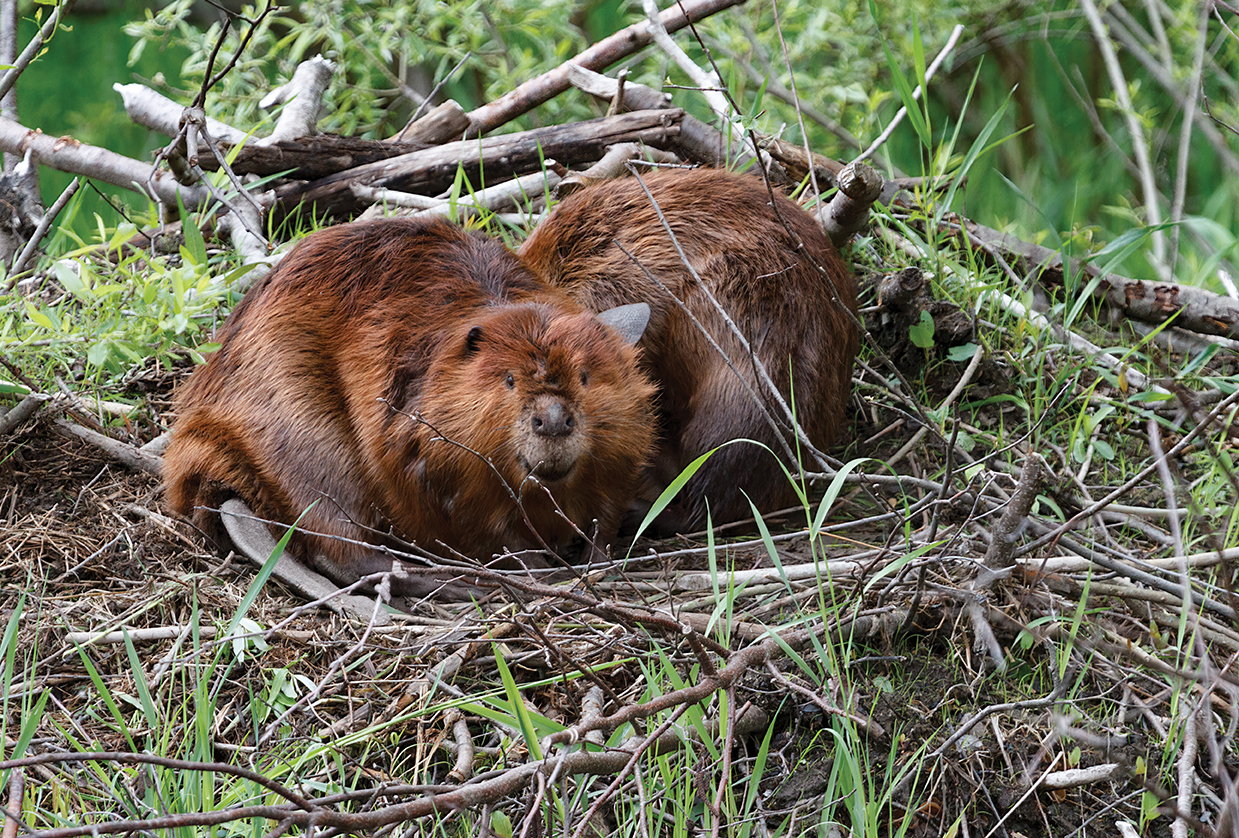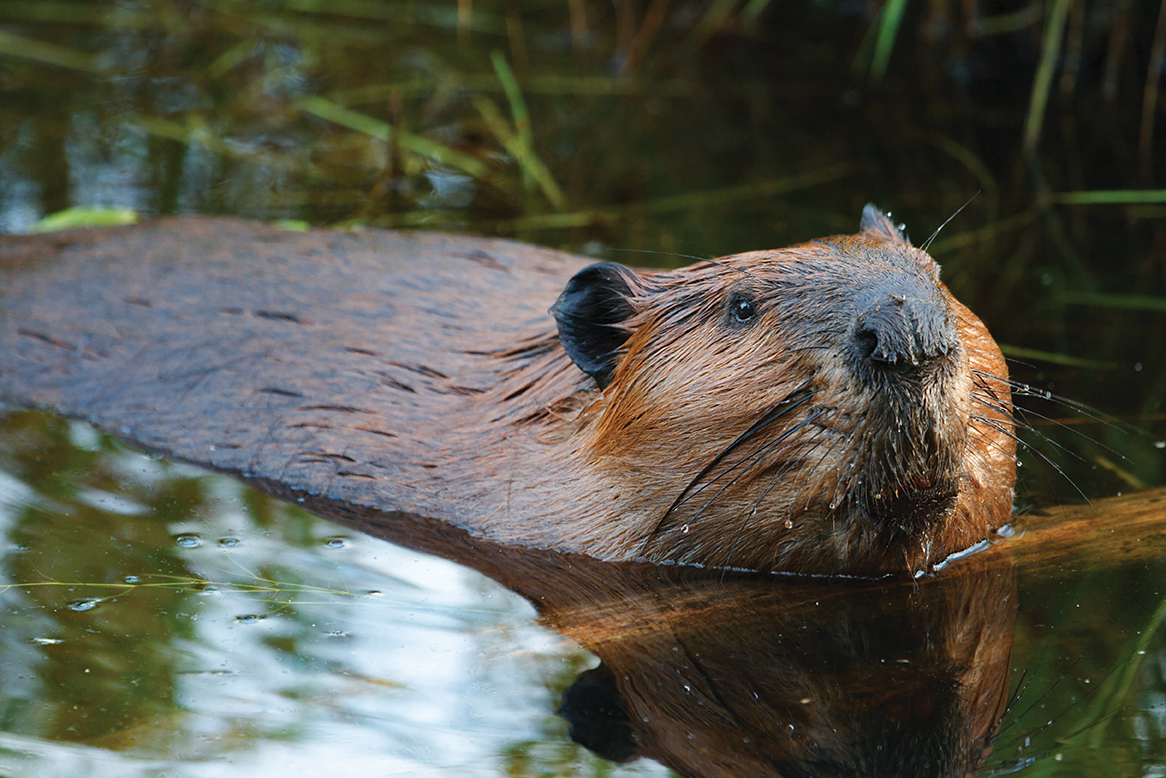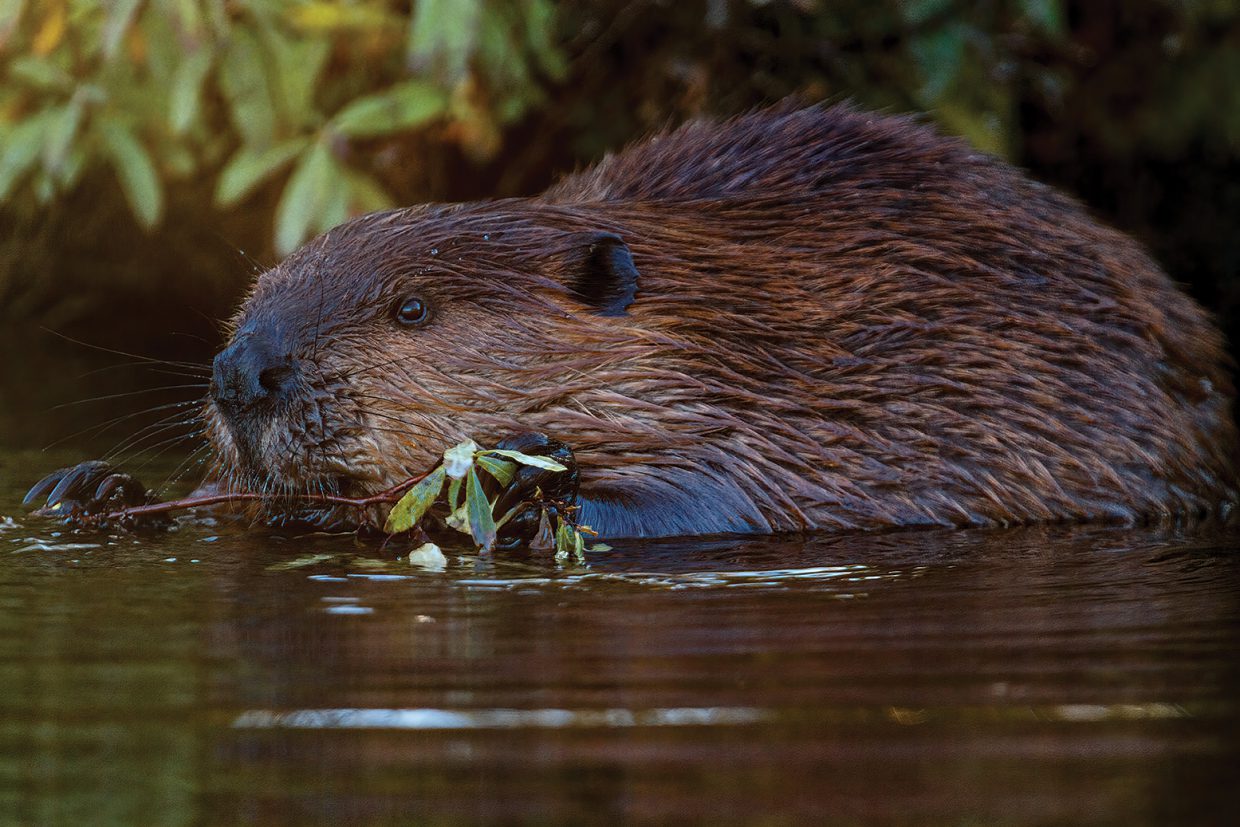
The Beaver
It’s hard to believe that a furry rodent could drive exploration of an entire continent, but that is the case with the beaver. Beavers have inhabited North America for thousands of years going back to the Ice Age with the giant beaver (Castoroides ohioensis), a fearsome looking creature that has been given credit for creating the fertile bottomlands sought out by settlers. An exhibit can be seen at the Pequot Museum in Mashantucket. Like its fellow giants of the age, it went extinct.
Our beaver (Castor canadensis) is a much smaller species but no less remarkable. From its nose to its tail, it is especially adapted to its watery habitat. The beaver’s nose, mouth, and ears close snuggly to keep out moisture while it is diving and swimming under water. Its eyes have a second eyelid called a nictitating membrane that protects the eyes while the beaver is working under water, much like built in goggles.
This semi-aquatic rodent has two sets of distinctly different feet that help it maneuver on land and in the water. The smaller front pair are much like hands and function as such for grabbing, carrying, and lifting. The rear feet are larger and webbed and act as paddles moving the beaver through the water while its flat tail is adjusted to function as a rudder. The tail helps balance the beaver especially when felling trees. The tail is also the beaver’s alert system. It is slapped hard on the surface of the water to send an alarm to the rest of the beaver family when there may be danger. The beaver then dives deep and swims fast away from the threat. You probably won’t see it surface again for quite some time because it can hold its breath for five to ten minutes. Its large liver and lungs give it a greater capacity than humans for oxygen exchange. When the beaver is submerged, the blood to the extremities stops in favor of the brain.
 And then there are the beaver’s famous teeth. Two pairs of long front incisors are covered on the outside with enamel that gives them their orange color. It is harder than the underlining dentine and helps create their pointy wedge shape that works well in the task of tree cutting. A sapling can be cut with one bite. You will often find twigs that have been chewed across the way some of us eat an ear of corn. The incisors grow continuously, and it’s important that the beaver uses them all the time. If it doesn’t, they could grow into the skull and kill the beaver. Beavers also have molars for chewing the tender bark of saplings once the bark is ripped off by the front teeth.
And then there are the beaver’s famous teeth. Two pairs of long front incisors are covered on the outside with enamel that gives them their orange color. It is harder than the underlining dentine and helps create their pointy wedge shape that works well in the task of tree cutting. A sapling can be cut with one bite. You will often find twigs that have been chewed across the way some of us eat an ear of corn. The incisors grow continuously, and it’s important that the beaver uses them all the time. If it doesn’t, they could grow into the skull and kill the beaver. Beavers also have molars for chewing the tender bark of saplings once the bark is ripped off by the front teeth.
While all of these aspects of the beaver’s physiology are amazing, it’s the fur that made it of interest to humans—and still does. Of all the fur-bearing animals in the world, the beaver’s fur is by far the best for keeping warm. There are two layers; the soft inner layer is highly prized for coats and for felting to make hats. (The new style of the silk hat saved the beaver from global annihilation.) The outer hairs, called guard hairs, are longer and stiffer and protect the inner layer from getting wet. A beaver has about 100,000 hairs per square inch (humans about 1,000.) Most beavers are dark brown in color, but the color can range from blond to jet black. The beaver protects the outer coat by spreading oil with a split toenail on the guard hairs that waterproofs the fur and acts as a wetsuit. The underlying thick skin insulates the body and allows the beaver to tolerate frigid water.
Beavers also have scent glands at the base of the tail containing castoreum oil. This oil is thick, yellow, and sweet-smelling and is used by the beaver for communication. The castor gland gives our beaver part of its Latin name. Castoreum is used for perfume making.
With all those amazing characteristics, you would think that would be enough to make the beaver one of nature’s most fascinating creations, but that is only the beginning. The beaver is best known for its job as a builder. When young beavers leave their families in the spring to find a new place to make a life, they look for a spot with running water that can be backed up to create a pond. This is done by building a dam, usually of wood from trees surrounding the site, starting with smaller branches that are stuck in the muddy substrate pointing upstream, and then just piling on more twigs and branches and stuffing in more mud until the water no longer flows. Beavers can hear the seeping through the dam and plug up the leaks with great expertise and in very short order.

While the water is deepening behind the dam, the beaver will live in a den in the muddy bank. After the water backs up to a sufficient depth, the beaver will pick a place for its lodge home. A big dome-shaped pile of sticks is created with mud waterproofing except for an air duct left in the center for ventilation. When the pile is big enough, the beaver gnaws its way into the lodge from under the water creating a hidden, secure entrance.
Once inside, upper and lower chambers are chewed out of the pile for sleeping and feeding quarters. More mud is brought in for insulation, making the lodge pretty much impregnable once the mud freezes. Shredded wood fibers are used for bedding to make the place comfortable for the family.
A beaver family usually consists of a monogamous pair, mated for life, with kits (babies) and yearlings, about eight in all. When a beaver reaches maturity at 22 months, it leaves to start a life of its own. The average life span is about ten years, and they weigh from 30–65 pounds as an adult.
In the winter, the family remains in the lodge. Entry to the lodge must be deep enough under the surface that it will not be frozen. If the water freezes over the entrance while the beavers are in the lodge, the family will starve to death. Caches of food are weighted down under the water just outside the lodge for winter feeding.
Once the beavers have established their dam and lodge, they continue to work on upkeep. As the water of the pond rises and more sunlight reaches the water from the thinning of the trees, other species take up residence, including ducks, geese, owls, herons, deer, moose, and trout.
Beavers are industrious hard workers. In the 1940s when the US was having erosion problems out West, beavers were parachuted into remote areas of Idaho to revitalize wetlands and control erosion with great success. Then Secretary of the Interior Harold Hickes boasted that he got $300 worth of conservation for $5 a head. In places where there were no trees, the beavers were supplied with tires for dam building!
Today, Native People are relocating beavers to reclaim Indigenous land management practices, especially in areas of drought. New Research reveals that beavers can be used to mitigate the spread of fire because beaver-inhabited land is too wet to burn.
While humans have assisted with dam construction, beavers do have food preferences, like aspen, cottonwood, and willow. They are known to eat and use most anything for their dam building purposes. Beginning with trees near the water source, beavers cut trees to fall in the water. This is done by standing uphill, bending the head, and biting off chips, starting with big bites and gradually smaller ones closer to the center of the tree trunk. When the beaver senses the tree is ready to fall, it runs for safety. It is rare for beavers to be hit by a falling tree. Once the tree is in the water, the beavers begin to cut it into lengths small enough to push or drag through the water to the right location. This is the only aspect of beaver life that is rather random. Sometimes, a tree will be cut and left. Sometimes, it will be dined on a bit and then cut up and used.
There are places where you will see stumps that have been cut high up the trunk of the tree. This is an indication that the tree was cut during the winter when the snow was deep. This only happens when there is a warm spell and the beaver pond isn’t frozen enough to keep the beavers in the lodge.
It’s hard to believe, but for nearly a century, beavers were no longer a part of Connecticut’s wildlife, having been extirpated by 1842. When Europeans arrived in North America, beavers were estimated to number from 60–400 million, ranging from the Arctic Circle to the Sonora in Mexico. It wasn’t until the early twentieth century that beavers again called Connecticut home. Between 1914 and 1940, the species was reintroduced to the state. In the early 1950s, there were twenty colonies. By 1965, there were 248. Relocating troublesome animals helped recolonize the state. Today, beaver colonies are everywhere and no longer moved. Problem beavers are removed by licensed trappers.
Consequently, the beaver is revered by some and reviled by others. It has been called everything from master engineer, choosy generalist, keystone species, old chisel tooth, to pest. But, make no mistake, this is an animal that is incredibly adapted to its habitat. In shaping its environment to survive, it provides for others. It is a cautious and deliberate animal, methodical and logical in its behavior. It is second only to man in its ability to modify the landscape.
Alison C. Guinness is a resident of East Haddam, Connecticut, where she researches the local earthquake phenomenon called the Moodus Noises. She is an historian and naturalist with interest in Portland brownstone and other quarrying in the Connecticut River Valley. She has curated exhibits at the Connecticut River Museum on brownstone, Connecticut River fish and wildlife, and boat building. She is currently studying Connecticut’s Cultural Stone Landscapes.

